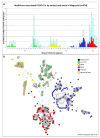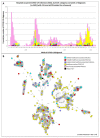Healthcare-Associated COVID-19 across Five Pandemic Waves: Prediction Models and Genomic Analyses
- PMID: 36298847
- PMCID: PMC9607632
- DOI: 10.3390/v14102292
Healthcare-Associated COVID-19 across Five Pandemic Waves: Prediction Models and Genomic Analyses
Abstract
Background: Healthcare-associated SARS-CoV-2 infections need to be explored further. Our study is an analysis of hospital-acquired infections (HAIs) and ambulatory healthcare workers (aHCWs) with SARS-CoV-2 across the pandemic in a Belgian university hospital.
Methods: We compared HAIs with community-associated infections (CAIs) to identify the factors associated with having an HAI. We then performed a genomic cluster analysis of HAIs and aHCWs. We used this alongside the European Centre for Disease Control (ECDC) case source classifications of an HAI.
Results: Between March 2020 and March 2022, 269 patients had an HAI. A lower BMI, a worse frailty index, lower C-reactive protein (CRP), and a higher thrombocyte count as well as death and length of stay were significantly associated with having an HAI. Using those variables to predict HAIs versus CAIs, we obtained a positive predictive value (PPV) of 83.6% and a negative predictive value (NPV) of 82.2%; the area under the ROC was 0.89. Genomic cluster analyses and representations on epicurves and minimal spanning trees delivered further insights into HAI dynamics across different pandemic waves. The genomic data were also compared with the clinical ECDC definitions for HAIs; we found that 90.0% of the 'definite', 87.8% of the 'probable', and 70.3% of the 'indeterminate' HAIs belonged to one of the twenty-two COVID-19 genomic clusters we identified.
Conclusions: We propose a novel prediction model for HAIs. In addition, we show that the management of nosocomial outbreaks will benefit from genome sequencing analyses.
Keywords: genomic analysis; healthcare-associated COVID-19; prediction modelling.
Conflict of interest statement
The authors declare no competing interests.
Figures



References
-
- Wang D., Hu B., Hu C., Zhu F., Liu X., Zhang J., Wang B., Xiang H., Cheng Z., Xiong Y., et al. Clinical Characteristics of 138 Hospitalized Patients with 2019 Novel Coronavirus-Infected Pneumonia in Wuhan, China. JAMA—J. Am. Med. Assoc. 2020;323:1061–1069. doi: 10.1001/jama.2020.1585. - DOI - PMC - PubMed
-
- Marago I., Minen I. Hospital-Acquired COVID-19 Infection—The Magnitude of the Problem. SSRN Electron. J. 2020 doi: 10.2139/ssrn.3622387. - DOI
-
- Nguyen L.H., Drew D.A., Graham M.S., Joshi A.D., Guo C.G., Ma W., Mehta R.S., Warner E.T., Sikavi D.R., Lo C.H., et al. Risk of COVID-19 among Front-Line Health-Care Workers and the General Community: A Prospective Cohort Study. Lancet Public Health. 2020;5:e475–e483. doi: 10.1016/S2468-2667(20)30164-X. - DOI - PMC - PubMed
-
- Rivett L., Sridhar S., Sparkes D., Routledge M., Jones N.K., Forrest S., Young J., Pereira-Dias J., Hamilton W.L., Ferris M., et al. Screening of Healthcare Workers for SARS-CoV-2 Highlights the Role of Asymptomatic Carriage in COVID-19 Transmission. Elife. 2020;9:e58728. doi: 10.7554/eLife.58728. - DOI - PMC - PubMed
MeSH terms
Substances
LinkOut - more resources
Full Text Sources
Medical
Research Materials
Miscellaneous

